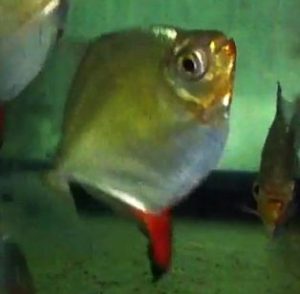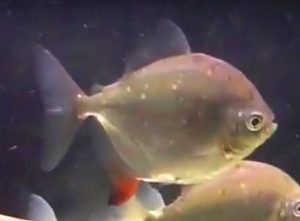The Red Hook (Myloplus rubripinnis) is found throughout Northern South America in the Amazon, Rio Orinoco, and many of the other major river systems. It has been collected in Brazil, Colombia, Ecuador, French Guiana, Guyana, Peru, Suriname, and Venezuela from the densely vegetated slower moving rivers and streams in these regions.
In the aquarium trade, Red Hooks are often sold to tropical fish keeping enthusiasts as “Silver Dollars” however, their red with black edged anal fin, noticeably smaller adipose fin, and larger adult size quickly distinguishes them from their Serrasalmidae cousins.
All Silver Dollar species are found in tropical climates and prefer weedy river tributaries, with dense overhanging vegetation that provides the low light conditions they prefer.
Like most Silver Dollars, the Red Hook is a peaceful, but skittish, schooling species. They are herbivores that in their natural habitat voraciously feed on the leaves of submerged and marginal plants however, they are opportunistic feeders that also eat earthworms, small crustaceans, grubs, insects, and smaller fish.
In an aquarium environment, Red Hooks needs a huge amount of vegetable matter in their diet to prevent them from decimating a well planted tank.
The Red Hook (Myloplus rubripinnis) has a round, silvery, laterally compressed body with a long red pointed anal fin edged in black and a much smaller adipose fin. They have small scales that give them a greenish blue sheen when viewed from different angles.
Although many tropical fish keeping enthusiasts say there is no way to differentiate between sexes, adult Myloplus rubripinnis can be sexed by the shape of their anal fin. Females seem to have pinker bellies and an anal fin that points outward towards the tail, and then down to a point. The anal fin in male Myloplus rubripinnis is usually somewhat longer and points almost straight down vertically, into the classic “J” shape.
Red Hooks do best in a densely planted, dimly lit aquarium of at least 75 gallon capacity, with a dark sand or fine gravel substrate, some pieces of driftwood, a few well placed rocks for them to hide among, and some floating plants to help diffuse any overhead lighting and reduce skittishness. Hardy plants like Java Fern
, Hornwort, etc. is recommended to minimize grazing. They require good water quality and regular water changes. A canister filter would be a good choice for this species to provide the water flow and quality necessary for their well being.
Because they are a schooling species, Myloplus rubripinnis do best when kept together with at least 5 or 6 other individuals in a single species biotope setup. They are quite peaceful, and many tropical fish keeping enthusiasts successfully house Red Hooks with other larger peaceful fish in a community tank environment however, at least 3 or 4 should be kept together with plenty of hiding places to keep them from becoming too skittish, or reclusive.
As of December 5, 2017 Red Hooks (Myloplus rubripinnis) have been successfully bred in an aquarium environment by at least one individual named Anthony in Dayton, Ohio. He was kind enough to let us know that he raised approximately 50 fry to adulthood in a 150 gallon tank.
All Silver Dollars require vegetable matter in their diet and the Red Hook is no exception. They should be fed commercial algae wafers, Spirulina flakes, cucumbers, lettuce, peas, zuchinni, spinach, and other fresh greens. They will also eagerly accept regular offerings of fresh, frozen, or freeze dried bloodworms, tubifex, earthworms, ghost shrimp
, and brine shrimp.
Myloplus rubripinnis are usually readily available in tropical fish keeping shops and online at reasonable prices. They are usually sold as juveniles when they are 1 1/2″ – 3″ or larger in size.
Minimum Tank Size: 75 gallons
Care Level: Moderate
Temperament: Peaceful
Aquarium Hardiness: Moderately Hardy
Water Conditions: 73-81 °F°, <10dgH, pH 6.0-7.0
Max. Size: 10″ or more
Color Form: Silver, Red
Diet: Omnivorous (primarily Herbivorous)
Compatibility: Aggressive to small fish
Origin: Northern South America
Family: Characidae (Serrasalmidae)
Life Span: 5-10 years or more
Aquarist Experience Level: Intermediate




My pair of red hooks laid eggs. On December 5, 2017 I found very very very tiny fry while siphoning. I moved them to a 10 gallon nursery tank and now Feb 5 2018 everyone including parents are in a 150 gal. Tank. I now have about 50 1 inch fish! They love newly hatched brine shrimp, lettuce an shelled frozen peas. So, is this a record? They HAVE been bred in captivity! Am I the only person ever to breed red hooks?? I have had the parents for 12 years. I wonder if people simply did not see the babies and the get siphoned since there are on line youtube videos of red hooks spawning. If you want to know more call me Anthony 937-299-7756. Now what am I going to do with 50 red hooks when they get big? If you live near Dayton OH and have a big tank call me!
Anthony,
You are the first hobbyist I’ve heard about who has bred Red Hooks in this country. If I was closer and I had room for another tank in my home I’d pick up a few. Unfortunately, I’m loaded up with Odball fish.
Thanks much,
John
P.S. I’m updating the info on Red Hooks this evening.
My red hooks had babies. They are now about one inch long. I noticed tiny fish while siphoning. I have been able to keep about 35 of them alive so far in a 5 gallon nursery tank. They are now eating brine shimp and powdered fry food. So, every web site says they have not been bred in captivity. Should I call the Guinness book of world records? The parents are about 12 yeas old and have been together as a pair in a 42 gallon tank for over 10 years. I do know this tank is just barley big enough for both of them. They can get skitish and crash into the glass. Ouch! The only other fish in the tank with them is fan tail tetra. They LOVE to eat cucumber, watermelon, peas, garbanzo beans, romaine lettuce, frozen brine shrimp, try anything veg that humans eat! Clearly I have a male and a female. I think the female is lager and chases the male. I have seen them mating but never seen eggs. The tank has a piece of wallaby wood ?? and java moss. Email at info@theyogastudio if you want babies in Dayton OH.